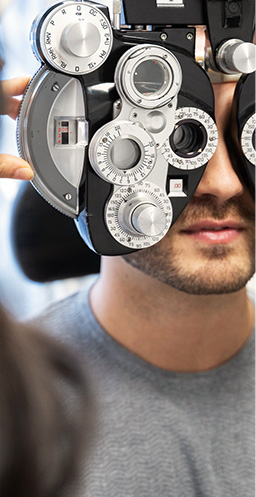If you’ve been feeling under the weather with a sinus infection and notice your eyes feeling off, you’re not alone. Because your sinuses are next to your eyes, it’s normal for a sinus infection to lead to:
- Swelling and puffiness around the eyes
- Pain or pressure
- Blurry vision
- Red or watery eyes
- Other rare complications
Recovering from a sinus infection doesn’t always require an optometrist. However, if you notice odd symptoms such as changes in your vision or discomfort around the eyes, this could signal an underlying concern that benefits from a closer look.
What Is a Sinus Infection?
Feeling stuffy and congested are tell-tale signs of a sinus infection. Although sinus infections are common and usually nothing to worry about, this doesn’t make having one any less uncomfortable.
Your sinuses are air-filled cavities behind your forehead, nose, and cheeks. They’re lined with mucus membranes that help trap dust, germs, and other unwanted particles. Sinus infections, also called sinusitis, happen when an infection causes swelling or inflammation.
Sinus infections typically result from:
- Viral infections, like the common cold or flu.
- Bacterial infections, which can develop when fluid builds up in the sinuses, creating a breeding ground for bacteria.
- Allergies, such as hay fever, that irritate the sinus linings.
Most people feel a “fullness” or pressure in their face when a sinus infection breaks out (likely because they’re located all around the face). Other common signs include:
- Nasal congestion or blockage.
- Facial pain, pressure, or swelling (especially around the eyes, forehead, and cheeks).
- Thick nasal discharge, which might be yellow or green in colour.
- Difficulty breathing through your nose.
- Persistent headaches.
- Fever, fatigue, or a general “run-down” feeling.
Given the location of your sinuses, it’s no surprise that a sinus infection can sometimes affect nearby structures, including your eyes!
Sinus Infections & Your Eyes
Your eyes and your sinuses are anatomically close. So, when sinus infections flare up, your eyes may join the party (and not in a fun way).
Here are ways a sinus infection can affect your eyes.
Swelling & Puffiness Around the Eyes
The sinuses behind and around your eyes (like the ethmoid and maxillary sinuses) experience inflammation during an infection. This can lead to noticeable puffiness or swelling around your eyes, giving you that dreaded “I’ve-been-up-all-night” look.
Pain or Pressure
Many people with sinus infections experience pain or pressure around their eyes. This occurs because sinus inflammation puts pressure on the tissues surrounding your orbital bones (which house your eyes).
This is why you might feel tenderness when you press on your cheeks or just behind your eyebrows.
Blurry Vision
Though not as common, significant sinus swelling or fluid buildup can sometimes disrupt your vision, leading to blurry vision, difficulty focusing, or even temporary double vision.
This is often because of the pressure affecting the muscles and nerves that control your eye movements.

Red or Watery Eyes
Inflammation from a sinus infection can sometimes spread to nearby structures, like the tear ducts. This can leave you with red, watery, or irritated eyes that might feel scratchy or uncomfortable.
More Serious Complications
While uncommon, untreated or severe sinus infections can lead to more serious eye-related complications, like:
- Orbital cellulitis: an infection of the tissues around the eyes.
- Abscesses: These can put pressure on the eye and impair vision.
- Vision Loss: This is extremely rare but possible in severe, untreated cases.
Don’t panic! These complications are rare, but they highlight the importance of addressing prolonged or severe sinus infections early.
How Your Optometrist Can Help
Our main takeaway is this: Do not ignore eye symptoms if you have a sinus infection.
If you’re experiencing unusual eye discomfort or vision changes during a sinus infection, we can play a key role in protecting your eye health. Here’s how:
Routine Eye Exams
We can perform a detailed eye exam to assess whether your eye symptoms are related to your sinus infection. We’ll look for signs of swelling, redness, or changes in the structures around your eyes.
Symptoms such as blurry vision or eye pain can result from other, underlying eye issues, such as dry eyes, conjunctivitis, or even undiagnosed refractive errors.
Regardless of the outcome, visiting your eye doctor is essential. We can differentiate between these possibilities and help you find a quick path to recovery.
Managing Eye Discomfort
If your sinus infection is causing eye irritation, we can help you manage symptoms.
We might recommend artificial tears to hydrate your eyes, a warm compress mask to relieve pressure, or even a humidifier to add moisture. Although these strategies may not tackle the infection directly, they can help keep you and your eyes more comfortable.
When to See an Optometrist
Not every sinus infection needs medical intervention; most viral cases clear up on their own within 10 days. But if you notice the following symptoms, it’s time to seek help:
- Persistent or worsening facial pain and swelling.
- Vision changes, like blurry or double vision.
- Severe pain or redness around one or both eyes.
- Light sensitivity
- High fever or a stiff neck.
Though eye doctors can’t treat sinus infections, they can help rule out or identify eye-related complications that accompany them.
Staying on top of your eye health helps preserve your vision and overall comfort, even if the underlying culprit isn’t vision-related.
Protect Your Eyes
Just because sinus infections are common doesn’t mean you should overlook the impact on your eyes. Swelling, pressure, and vision disturbances caused by sinus inflammation can all take a toll, but the good news is that relief is within reach.
Eye pain or discomfort during a sinus infection is your body’s way of signaling that something isn’t right and deserves attention.
If you’re dealing with eye symptoms and don’t know where to start, book an appointment with our team at Stoney Creek Eye Care. We’re here to help.









